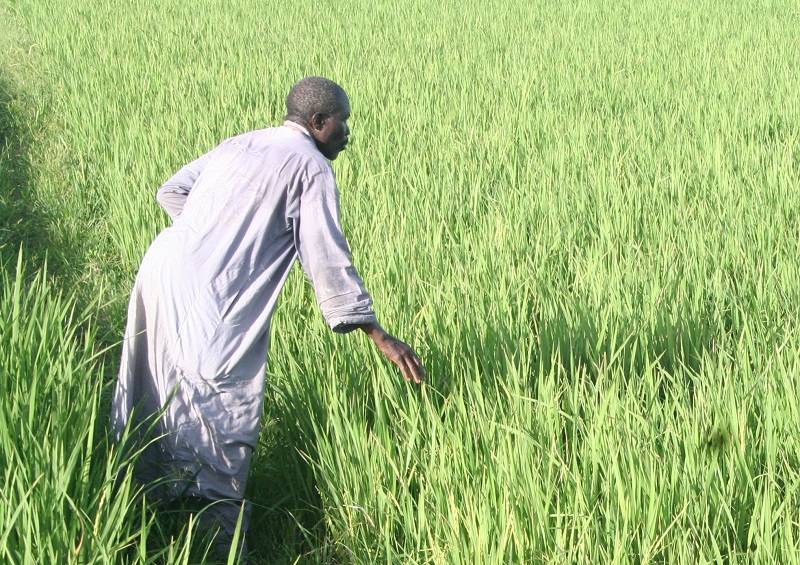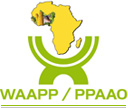
Mali 13 February 2018 /
The System of Rice Intensification (SRI) is helping bring rural farmers closer to food self-sufficiency in over 50 countries with the help of organizations like the West and Central African Council for Agricultural Research and Development (CORAF). It can potentially reduce water use, increase land productivity, and provide a buffer against the impacts of climate change while reducing reliance on artificial inputs, like pesticides and artificial fertilizer.
Mali, where rice is the staple food, imports more than 45 percent of its rice. The West Africa Agricultural Productivity Programme (WAAPP), a program at CORAF, introduced SRI methods to sustainably increase rice production and lower food insecurity. SRI creates two possible harvest periods in Mali, thereby reducing the length of the lean period. With increased income, farmers are purchasing food supplements and investing in education.
“With this practice, I can feed my family and the income generated enabled me to cover health costs and school fees for my children,” says Adama Dougnon, a rice producer in the Segou Region of Mali. “Before, I used to practice the broadcast seeding method. With 120 kilograms of paddy rice seeds I can reap 3-4 tonnes per hectare. Then I switched to a regular rice-transplantation system that allowed me to get about 5 tonnes with 80 kilograms of seeds per hectare. But the introduction of the SRI by WAAPP has significantly increased my yields. Currently, my yields are estimated in the range of 8 to 8.5 tonnes per hectare with a maximum of 15 kilograms of paddy rice seed used.”
“We should not need to have food shortages in the world if we would make better use of our existing land, water, seed, labor, and capital resources,” says Norman Uphoff, Professor Emeritus of Government and International Agriculture at Cornell University and Senior Advisor, SRI International Network and Resources Center (SRI-Rice).
Rice is the most important grain for human consumption, according to the International Rice Research Institute (IRRI) and the U.N. Food and Agriculture Organization (FAO). Globally, rice provides 20 percent of all calories consumed, with up to 70 percent in some regions. Rice is grown predominantly on smallholder farms and the average global yield is approximately four tons/hectare. While rice production has stayed level for decades, rice demand is steadily increasing as populations grow.
“Meeting our food needs more adequately, more equitably, and more sustainably is not going to be possible with our current technologies and mindsets, given the growing constraints of climate change,” says Uphoff. “What we are learning about the contributions that beneficial microbes can make to crop and animal (as well as human) growth and health is itself an inspiration and impetus for multidisciplinary, collaborative work on agricultural and rural development.”
SRI is a crop management approach developed by Fr. Henri de Laulanié in Madagascar in 1983. The goal is to create nutrient-rich soil and provide individual plants with the space to grow, allowing them to develop a stronger root system. This leads to stronger plants and larger yields. For irrigated rice production, farmers transplant young, single seedlings, spacing them widely in a grid pattern. They keep soils moist and fertile but not flooded, enhancing them with compost and other sources of organic nutrients. Weeding is done early and regularly, aerating the soil, with weeds added back to the soil to decompose. These practices can be adapted to local conditions, such as water availability, soil conditions, weather, labor availability, and access to seeds.
Adapting SRI practices can double yields while reducing costs by a quarter and saving up to 40 percent more water. In Bihar, India, large increases in productivity and a host of socio-economic benefits were seen, especially among women. In northern Myanmar, under rainfed conditions, households’ net incomes from rice production increased eight-fold. According to Oxfam, “growing more rice with less water and agrochemical inputs is essential for future food security and environmental sustainability.” More than 50 countries are applying SRI methodology and modifying practices accordingly.
“For subsistence farmers, this kind of increase can mean the difference between not having enough rice to eat and being food self-sufficient. That’s huge,” says Caryl Levine, Co-Founder and Co-Owner of Lotus Foods. “They often achieve household self-sufficiency within just one or two cycles, and after that, they have surplus to sell. Our supply chain partner in Cambodia found that the net income, after input and labor expenses, from cultivating rice was highest for farmers who are producing SRI organic rice, with income of up to US$745; traditional farmers experienced a loss of around US$70.”
The original article was first published on Foodtank







